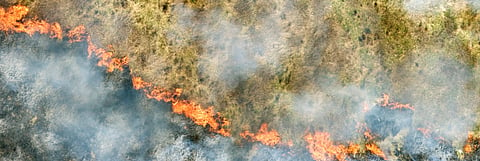Air Quality Sinks as Climate Change Accelerates
An anticipated rise in the frequency, intensity and duration of heatwaves and an associated increase in wildfires this century is likely to worsen air quality, harming human health and ecosystems.
The interaction between pollution and climate change will impose an additional “climate penalty” for hundreds of millions of people, according to a new report from the World Meteorological Organization (WMO).
The annual WMO Air Quality and Climate Bulletin reports on the state of air quality and its close interlinkages with climate change. The bulletin explores a range of possible air quality outcomes under high and low greenhouse gas emission scenarios.
The WMO Air Quality and Climate Bulletin 2022 focuses in particular on the impact of wildfire smoke in 2021.
As in 2020, hot and dry conditions exacerbated the spread of wildfires across western North America and Siberia, producing widespread increases in particulate small matter (PM2.5) levels harmful to health.
“As the globe warms, wildfires and associated air pollution are expected to increase, even under a low emissions scenario. In addition to human health impacts, this will also affect ecosystems as air pollutants settle from the atmosphere to Earth’s surface,” says WMO Secretary-General Prof Petteri Taalas.
“We have seen this in the heatwaves in Europe and China this year when stable high atmospheric conditions, sunlight and low wind speeds were conducive to high pollution levels,” said Prof Taalas.
“This is a foretaste of the future because we expect a further increase in the frequency, intensity and duration of heatwaves, which could lead to even worse air quality, a phenomenon known as the “climate penalty,” he said.
World had One of Three Warmest Julys on Record: WMO
The “climate penalty” refers specifically to the climate change amplification effect on ground-level ozone production, which negatively impacts the air people breathe.
The regions with the strongest projected climate penalty – mainly in Asia - are home to roughly one quarter of the world's population. Climate change could exacerbate surface ozone pollution episodes, leading to detrimental health impacts for hundreds of millions of people.
The Air Quality and Climate Bulletin, the second in an annual series, and an accompanying animation on atmospheric deposition was published ahead of International Day of Clean Air for blue skies on 7 September.
The theme of this year’s event, spearheaded by the UN Environment Programme, is The Air We Share, focusing on the transboundary nature of air pollution and stressing the need for collective action.
Air quality and climate are interconnected because the chemical species that lead to a degradation in air quality are normally co-emitted with greenhouse gases.
Thus, changes in one inevitably cause changes in the other. The combustion of fossil fuels (a major source of carbon dioxide (CO2)) also emits nitrogen oxide (NO), which can react with sunlight to lead to the formation of ozone and nitrate aerosols.
Air quality in turn affects ecosystem health via atmospheric deposition (as air pollutants settle from the atmosphere to Earth’s surface).
Deposition of nitrogen, sulfur and ozone can negatively affect the services provided by natural ecosystems such as clean water, biodiversity, and carbon storage, and can impact crop yields in agricultural systems.
Wildfires in 2021
The European Union’s Copernicus Atmosphere Monitoring Service measures global particulate matter. PM2.5 (i.e. particulate matter with a diameter of 2.5 micrometers or smaller) is a severe health hazard if inhaled over long periods of time.
At the global scale, observations of the annual total burned area show a downward trend over the last two decades as a result of decreasing numbers of fires in savannas and grasslands (2021 WMO Aerosol Bulletin).
However, at continental scales, some regions are experiencing increasing trends, including parts of western North America, the Amazon and Australia.
Future scenarios
The Intergovernmental Panel on Climate Change (IPCC) Sixth Assessment Report (AR6) includes scenarios on the evolution of air quality as temperatures increase in the 21st century.
It has assessed that the probability of catastrophic wildfire events –like those observed over central Chile in 2017, Australia 2019 or the western United States in 2020 and 2021– is likely to increase by 40-60% by the end of this century under a high emission scenario, and by 30-50% under a low emission scenario.
A worldwide carbon neutrality emissions scenario would limit the future occurrence of extreme ozone air pollution episodes.
The IPCC suggests that the low-carbon scenario will be associated with a small, short-term warming prior to temperature decreases.
This is because the effects of reducing aerosol particles, i.e. less sunlight reflected into space, will be felt first, while the temperature stabilization in response to reductions in carbon dioxide emissions will take longer.
However, natural aerosol emissions (e.g., dust, wildfire smoke) are likely to increase in a warmer, drier environment due to desertification and drought conditions, and may cancel out some of the effects of the reductions in aerosols related to human activities.
A future world that follows a low-carbon emissions scenario would also benefit from reduced deposition of nitrogen and sulfur compounds from the atmosphere to the Earth’s surface, where they can damage ecosystems.
The response of air quality and ecosystem health to proposed future emissions reductions will be monitored by WMO stations around the world, which can quantify the efficacy of the policies designed to limit climate change and improve air quality.
Read More: New Financing Mechanism for Climate Action Becomes Operational


